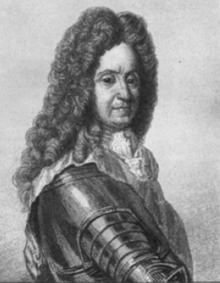Camille d'Hostun de la Baume, duc de Tallard
Camille, duc d'Hostun, comte de Tallard or Tallart (born February 14, 1652 in the Dauphiné , † March 20, 1728 in Paris ) was a French statesman and Marshal of France . As a lutenist , he composed numerous pieces for the instrument.
Live and act
Tallard fought first under the great Condé in the Netherlands , then in 1674 and 1675 under Turenne in Alsace and in 1678 as Maréchal de camp on the Rhine. In 1690 he crossed the Rhine on the ice in order to plunder the Rheingau . In December 1692 he led the siege of the Rheinfels fortress in St. Goar, but had to surrender his command to Thomas de Choisy due to a serious gunshot wound, who continued the siege.
Tallard composed several lute suites that appeared around 1700.
In the War of the Spanish Succession in 1702 he commanded a corps on the Rhine under the command of the Duke of Burgundy, Louis de Bourbon , and supported the French troops in the siege of Kaiserswerth . In 1703 he became Maréchal de France , conquered Breisach , besieged Landau and defeated the Prince of Hesse, Friedrich von Hessen-Kassel , who was coming for relief , near Speyer (→ Battle of the Speyerbach ). In 1704 he besieged the city of Villingen unsuccessfully with 29,000 men . In the further course of the War of Succession he occupied Regensburg in 1704 and led 35,000 auxiliary troops to the Bavarian Elector Maximilian II Emanuel in order to penetrate Austria together with him. But because of his short-sightedness in the battle of Höchstädt by Hessian dragoons under Karl von Boyneburg of the 1st Hussar Regiment (Hesse-Kassel) in English captivity when he wanted to cross the Danube near Sonderheim (now part of Höchstädt an der Donau ) . As a prisoner, Tallard made a trip to the capitals of the states whose soldiers had captured him, including Kassel. The sword he handed over and his gloves came into the possession of the Landgrave of Hessen-Kassel Friedrich as spoils of war. He stayed in Nottingham until 1711, where he spent his time in Newdigate House . There he benefited his country by the skill with which he helped to overthrow the Whigs and Marlboroughs .
After his release from captivity (1712) he received the title of duke, in 1715 the dignity of peers . Since then he has lived for the sciences and statecraft. In his will, Louis XIV appointed him a member of the Regency Council, but the Duke of Orléans , as regent, did not carry out this provision. In 1724 the Académie des Sciences elected Tallard as its president. In 1722 he bought a Hôtel particulier in Paris , now known as the Hôtel de Tallard , where he spent the last years of his life. From Louis XV Appointed Minister of State in 1726, he died on March 20, 1728.
literature
Camille de Tallard: Campagne De Monsieur Le Maréchal De Tallard En Allemagne L'An MDCCIV. Amsterdam 1763 ( online ).
Individual evidence
- ^ IMSLP: Camille de Tallard .
- ↑ Hubert Zanoskar (ed.): Guitar playing of old masters. Original music from the 16th and 17th centuries. Volume 1. B. Schott's Sons, Mainz 1955 (= Edition Schott. Volume 4620), p. 19 f. ( L'Entrée and Gavotte by Count Tallard, around 1700) and 24 ( Biographical Notes and Notes ).
- ↑ Monuments of Tonkunst in Austria . Volume 50 (see digitized version ).
- ↑ Josef Zuth: Handbook of the lute and guitar. Verlag der Zeitschrift für die Gitarre, Vienna 1926–1928, p. 269.
- ↑ Herders Conversations-Lexikon , keyword Boyneburg
- ^ New Prussian Adels Lexicon , First Volume, 1843, p. 272.
- ^ Association for Hessian History and Regional Studies, 1897: Smaller essays and Mittheilungen. A new poem on the battle of Höchstädt , p. 138.
- ^ Christian Röth: History of Hessen. Kassel 1856, pp. 322-323 ( Munich Digitization Center ).
- ↑ Johannes Erichsen, Katharina Heinemann: The battle of Höchstädt - The battle of Blenheim. Focus of Europe 1704. Ostfildern 2004, ISBN 978-3-7995-0215-3 , pp. 204–205.
- ↑ Herders Conversations-Lexikon, keyword Tallard
| personal data | |
|---|---|
| SURNAME | Tallard, Camille d'Hostun de la Baume, duc de |
| ALTERNATIVE NAMES | Tallard d'Hostun de la Baume, Camille duc de; Hostun de la Baume, Camille duc de Tellard d ' |
| BRIEF DESCRIPTION | French general and statesman, Marshal of France |
| DATE OF BIRTH | February 14, 1652 |
| PLACE OF BIRTH | Dauphiné |
| DATE OF DEATH | March 20, 1728 |
| Place of death | Paris |

